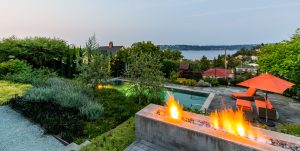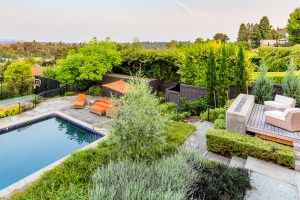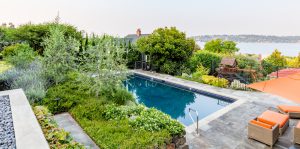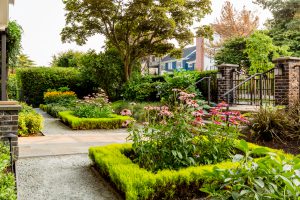Tag Archives: raised beds
A Beginner’s Guide to Growing a Bountiful Garden
A Beginner’s Guide to Growing a Bountiful Garden

Photo via Pixabay
By Carrie Spencer for Seattle Landscape Architect Brooks Kolb
Want to start a garden? Planting a garden is a wonderful way to spend more time outside, enjoy some good exercise, and have access to healthful food right in your backyard. But if you’ve never grown a garden before, it can be difficult to know where to start. From choosing the right plants to keeping weeds and pests at bay, there are several tips and tricks that experienced gardeners use to ensure a bountiful harvest at the end of every growing season. Keep on reading to learn how you can earn your own green thumb!
Start with Raised Beds
As opposed to planting straight in the ground, gardening in raised beds is a lot more manageable for beginners. This is also a great way to optimize your use of garden space. According to Savvy Gardening, raised beds prevent soil compaction and provide good drainage, so your plants will be less susceptible to root suffocation and rot. Not only that, but raised beds may deter pests like slugs and snails, which can eat up your adorable sprouts before they even get a chance. Finally, raised beds offer a more ergonomic gardening option to reduce strain on your back and neck.
Know Your “Sunset” Zone
You might already have an idea of the kinds of vegetables you would like to grow in your garden, but don’t go buy seeds just yet! It’s important to be aware of our growing season in the Pacific Northwest. The U.S. Department of Agriculture (USDA) has developed a numbered system to divide the country into frost-hardiness zones based on climate, but Sunset Magazine offers a more finely-calibrated zone chart for our region. Seattle, Mercer Island, Bellevue, and the Puget Sound lowlands are in Sunset Zone 5, whereas the Cascade foothills are in Zone 4. Determine your zone and be sure to read your seed packet labels to check when it’s best to plant to ensure a good crop. Working with plants that will thrive in your climate zone will be much easier than fighting against an early frost or high summer temperatures.
Learn About Companion Planting
The easiest way to grow a garden is to let your garden take care of itself. Select plants that like to grow next to each other—they will provide a natural source of nutrients, shade, and pest-control. As The Old Farmer’s Almanac explains, three common plants to grow together are corn, pole beans, and squash. The squash provides ground cover to reduce moisture loss and weed growth, the corn provides climbing support for the beans, and the beans help make nitrogen available in the soil for the other plants. Some other great companion plant combinations include radishes and carrots, tomatoes and basil, and lettuce and garlic.
Fertilize Your Garden
Just like us, plants need food. Fertilizing your garden properly will play an important role in its success, so spend some time learning the ins and outs of fertilization. In short, you want to provide your plants with three primary elements—nitrogen, phosphorus, and potassium. Providing these nutrients will help your garden flourish! However, you also have to be careful to avoid overfertilizing your plants, which can damage or even kill them. To find out exactly how much fertilizer to feed your garden, bring a sample of your soil to a testing lab and have it analyzed before amending it with any added nutrients.
Enjoy Your Harvest!
One of the largest benefits of growing your garden is having all of that veggie goodness right at your fingertips. To make the most of your backyard bounty, find recipes that showcase the flavors of your homegrown vegetables. For your tomatoes, consider an heirloom tomato seafood platter or make your own sauce. Whip up a homemade pesto with all of that beautiful basil or use it to add flavor to your weeknight dishes. The opportunities for healthful and delicious meals are truly endless!
Gardening might seem like a lot of work, but it’s a worthwhile hobby that just keeps on giving. Once you get started, you’ll quickly find that digging around in the dirt, pulling weeds, and watering your sprouts is an incredibly therapeutic activity. You’ll always be looking for new ways to expand your backyard plot, so get outside in the fresh air and get your garden started today!
Ask for Help
If you’re feeling overwhelmed and unsure of how to get started, consider working with a professional landscape architect to help you out. Brooks Kolb LLC can guide you through the process of designing the perfect garden. All key elements will be addressed, from construction materials to the plants you want to grow.
Seattle Landscape Architect Brooks Kolb can help you create the perfect garden that seamlessly blends form and function. Contact us at (206) 324-0858 for a free initial consultation!
 Garden writer Carrie Spencer can be reached at carrie@thespencersadventures.net.
Garden writer Carrie Spencer can be reached at carrie@thespencersadventures.net.
Recent Work: A Cascadia Avenue Garden
Seattle Landscape Architect Brooks Kolb is proud to announce the completion of an extensive new garden on Cascadia Avenue in the Mount Baker garden. The front garden features six rectangular perennial beds flanking the central front walk, while the much larger back garden boasts a substantial number of amenities: a swimming pool, shed with kitchenette, sports court and children’s play area. A raised hot tub is situated to look out over the flames of a custom, natural gas-fed fire feature to views of Lake Washington beyond. In addition, a custom tree house nestles in an Evergreen Magnolia tree for the owner’s young children. More than thirteen varieties of fruiting trees, shrubs, vines and espaliers are distributed throughout the garden, all without blocking views of the lake. Brooks collaborated with architect Kim Lavacot for the shed and tree house.
Photographs by Miranda Estes Photography






